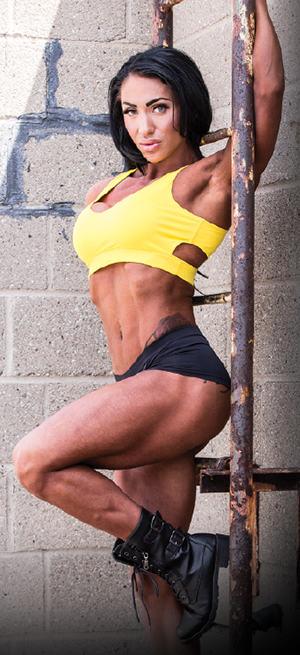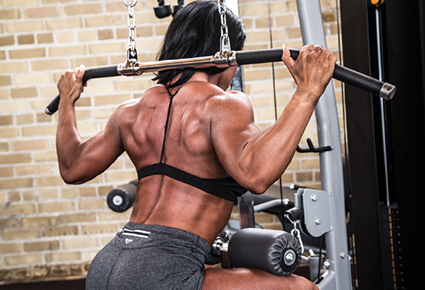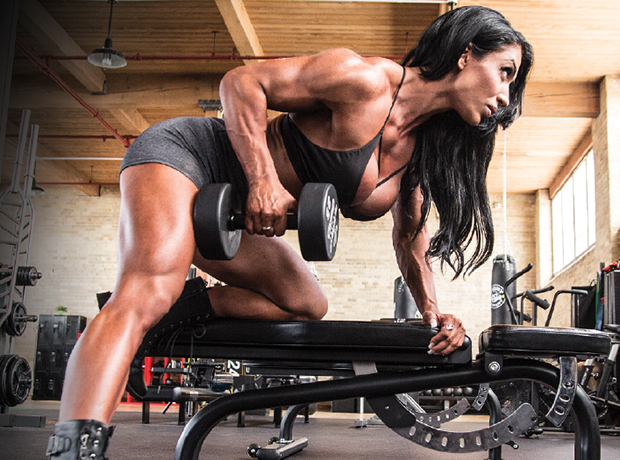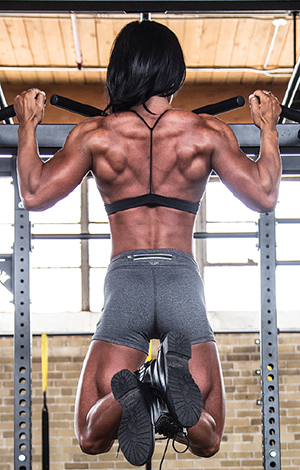AZARIA GLAIM BACK TRAINING

BACK TO BASICS—MUSCLE INSIDER Reveals the Back Training Secrets of Canada’s Youngest IFBB Figure Pro, Azaria Glaim
At 20 years old, in 2014, she became Canada’s youngest figure pro. Then she went on to place third and fifth at her first two IFBB Pro shows. Not one to rest on her laurels, Azaria Glaim wants more than just the “youngest figure pro” title. She wants a pro win. She wants to put the past versions of what she brought to the stage to shame. She wants to compete among the best in Vegas this year at the Olympia. There’s no balance in Azaria’s life, and she knows it. There’s no drinking, no smoking, no going out late or partying. There’s work, there’s training, and there’s no other life she’d rather lead. That’s what it takes to make a champion: attention focused solely on the task at hand and the larger goal. Read on to get inspired by one of the hardest working pros in Canada.
MUSCLE INSIDER: Tell us what’s been going on with you recently! You just finished competing at the Toronto Pro, where you placed a very respectable fifth in a tough lineup of figure girls. What was that experience like?
AZARIA GLAIM: Well, it was my first show of 2017, and it was the show where I had my pro debut two years ago. It was cool to revisit it. At my pro debut where I placed third, it was insane to be in a lineup with veterans like Genn Strobo; beyond my wildest dreams. Just an amazing experience. I keep training hard and making improvements to my physique, and getting more connections with people in the industry. The actual time we get onstage is very limited, so connecting with people is what I really look forward to when I get to shows.
MI: What got you into fitness, and what made you decide that you wanted to compete the first time?
AG: MUSCLE INSIDER columnist Darren Mehling, whom I’ve been working with for four years, actually had someone recruit me while I was living in Calgary. There was a guy at the gym who saw that I had a lot of potential, despite the fact that I’d never competed before. He put me in contact with Darren, who said that by the end of the year [2014] I would be an IFBB Pro. I kind of laughed at him because I thought it was an amazing idea, but I’d never done a show before. It was a little far-fetched, but I was willing to try it. I met him for the first time a week or so before my first show. I won my class at regionals, went on to do provincials, won my class there, and then two weeks after provincials, I did nationals and took the overall there. That’s when I got my IFBB pro card. It all happened in four weeks, back-to-back-to-back. I didn’t want to stop because I knew I had it in me. I had the mind-set that I could achieve it, and I had the right guidance with Darren.
MI: What made you decide to take your training to the next level and compete?
AG: I’ve always found training very therapeutic. I’m not a drinker, I don’t go out, and the gym is my choice of a good time. Darren said this would be a good fit, and I’m very intuitive, so I knew that I could do this if I took the chance. We’ve just never looked back since.
MI: Do you think your meteoric rise and all the notoriety that came with your pro card affected you, be it positively or negatively?
AG: I think there were both positives and negatives, depending on how you look at it. It took away from a lot of my life. So to some people, that would be a negative, but if you have a great support system and a lot of people surrounding you, then it wouldn’t be bad. For me, I’ve had a lot of support, and I don’t feel like there was negative. It just made me work extremely hard. I tried to stop myself from getting down when competing started to take up, but through stuff like meditation and checking back in with yourself, you can restore the balance. Then you’re not resentful towards the show.
MI: You were Canada’s youngest figure pro. What did the title mean to you at the time?
AG: It took a lot for me to really absorb it. Even now when I hear it, it still sounds so crazy. But there was never really a lot of pressure on me because I was just doing as much as I could do. I did it for me, and I loved it. There was nothing negative about the title though. It gave people a lot of hope and drive, and it gave people motivation to try and do the same thing. I believe there’s enough success in this world to go around. There’s so much room for physical, spiritual, and emotional growth, and we can all take part of that.
MI: What’s next for you in terms of competing?
AG: I was going to do the Vancouver Pro show, but I decided against it. I just didn’t feel like I could fully put 100 percent into my prep. There’s a pro show every single month in the United States, so when we feel my physique is ready for the next show, I will do it, but not before.
MI: How does your training and nutrition change in the off-season?
AG: off-season is very structured. I don’t stray too far from my conditioning year round, so getting in shape is pretty easy. In the off-season, Darren has me increase my food intake and I lift heavier. I’m still young, so I just need to build muscular maturity, but that’ll come with time. I focus on legs, back, and keeping my waist tight. I feel like in this sport, if you’re going to succeed, you have to be obsessed with it. You can’t be balanced, because that won’t get you ahead. I could enjoy food more, but that wouldn’t get me ahead. Everything I do in life is designed to get me ahead and help me reach my goals—if it doesn’t help, then I don’t do it.
 AZARIA'S BACK TRAINING ROUTINE
AZARIA'S BACK TRAINING ROUTINE
1. Wide-grip pull-downs behind the neck
• Your upper back, for any motion, will never fully contract unless your back is arched.
So for any movement, you want that arch in your back.
• Ensure the top of the bar doesn’t go above your head, because the muscles are fully contracted at that point, and anything further can increase your risk for injury.
• Space your hands out wider than shoulder width apart.

 2. Seated rows (narrow and wide grip)
2. Seated rows (narrow and wide grip)
• Ensure a full stretch at the bottom of every rep, and at the top, ensure your back is arched for complete muscle contraction.
• The difference between wide and narrow grips is that wide hits your upper and mid back, and narrow hits the lower lats and mid-back thickness.
3. Bent-over one-arm dumbbell rows
• Stabilize your core and scapula.
• Keep your elbows close to your torso for contraction of the lats.
• Make sure you’re getting a full stretch on the way down.

4. Wide-grip pull-ups
• Initiate movement by stabilizing the scapula to allow the back and other posterior muscles to be engaged with constant tension.
• Be sure to control all phases of each rep: eccentric, isometric, and concentric.

5. Bent-over barbell rows
• Stabilize your core and scapula.
• Keep your elbows close to your torso for contraction of the lats. (I got this tip from 6-time Mr. Olympia Dorian Yates!)
 AZARIA’S BACK WORKOUT TIPS:
AZARIA’S BACK WORKOUT TIPS:
“I train back once a week, typically. But sometimes I get a little bit antsy and do it on my rest days. Right now, I’ve been playing around with reps. I’ll start with wide-grip pull-downs or behind-the-neck pull-downs, and rep out 15 to 20 for a heavier weight, and just keep doing drop sets. I’ll do that about three times. But that’s only in my off-season. For show prep, I keep it simple and do 12 to 14 reps and maybe 4 sets.”
Photos by: Dave Laus

